BY ANN FARMER
Photos by Kristine Larsen
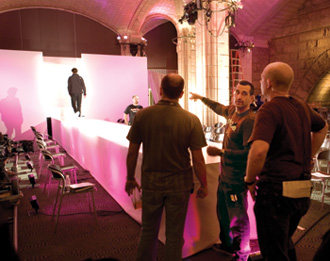 MAKEOVER: Tony Croll (center) transforms a restaurant's interior into a
MAKEOVER: Tony Croll (center) transforms a restaurant's interior into a
glamorous runway using pink and purple lighting.
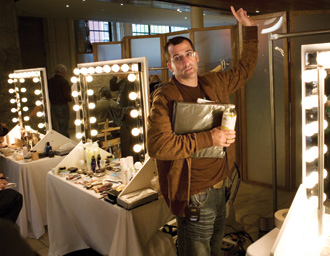
Croll adjusts the light so it doesn't bounce too much off the mirror.
One day during the November shooting of the latest and 12th cycle of the hit reality show America's Next Top Model, director Tony Croll arrives on location just as dark clouds begin looming overhead. In minutes, he is scheduled to direct an outdoor scene, filming the newest batch of contestants as they arrive at a Manhattan restaurant that is today's secret location. Although the wannabe models don't know it, crewmembers began hours ago to slowly transform the restaurant's interior into what will become a glamorous runway set packed with 400 cheering spectators for a glittering live event this evening. And it's up to Croll to make it all come together.
Even as some droplets of rain hit the pavement, Croll just keeps moving. "Get the bridge shot," he says, crouching beside a camera operator and framing the city skyline between his outstretched thumbs and forefingers. "Claudia, did you shoot them in the van?" he queries his segment director, Claudia Frank, through his headset to ensure that the contestants are being videotaped as they go from the house they are staying in to the restaurant.
Continuing along, Croll begins a walk-through of the interior setup. First stop is the designated hair and makeup corner, where the contestants will be shot getting dressed for their first runway show. The lighting is bouncing badly off the mirrors. "I'm worried about squeezing down these mirrors," he says, instructing his gaffer to lower the bulb intensity. Just then, an acrid smell fills the air. "D.C., it smells like smoke," he says, calling to David Charles, his associate director, who sticks close by to solve problems like this. Without missing a beat, Croll returns to his discussion of lighting.
No matter how many details he has to sort through, how much multitasking he must accomplish, how many people tap him on the shoulder, Croll remarkably never seems to get rattled. For the rest of the day, he leads his directorial team, which includes an associate director, three segment directors, and more than 100 crewmembers, to pull off the ambitious staged event. Just as tomorrow they will contend with a brand new location and for the rest of the two months that it takes to complete this whirlwind of a production schedule.
"I think the reality director job is the hardest," says Croll, a wiry, energetic and personable 36 year old who is on his third cycle of America's Next Top Model. "I've been good to reality TV and reality TV has been good to me." However, he adds, "It's physically and emotionally demanding, there's not enough money, locations are always falling through. Scenarios are falling through. We have to adapt all the time."
For instance, minutes before the competitors arrive, Croll discovers that the usual limo didn't pick them up because it broke down. The car service company sent a van instead. "I didn't want to show a 15-passenger van," says Croll, who quickly adjusts.
Also, critical lighting fixtures weren't ordered. "And we lost art," he says, indicating an enormous, shimmering wall sculpture in the restaurant that Croll had wanted to incorporate into the background, but was just told couldn't be shown. Still, he says, "Days like today are good days because I can control things," referring to the unruly, unscripted and fast-paced nature of reality shows.
"I look at it as making the best product within the parameters," says Croll. "That's part of the fun," explaining how he constantly weighs tight deadlines and budget concerns against the creative side. For instance, if the budget doesn't permit using a helicopter for an aerial shot, he'll look for a crane. "If we can't get a crane," he says, "get me a 12-foot stepladder."
Like many other television programs, America's Next Top Model is a house-based reality show. The contestants, who are competing for the opportunity to launch a modeling career, live together in a house. They undergo runway coachings, makeovers, photo shoots and fashion challenges that are shot at different locales every day.
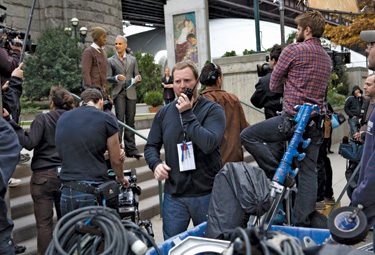 LIVING LARGE: Associate director David Charles is the problem solver.
LIVING LARGE: Associate director David Charles is the problem solver.
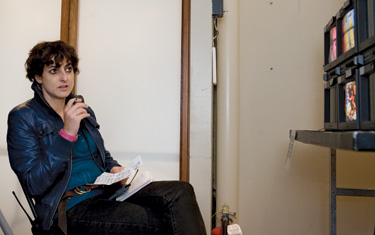
Segment director Claudia Frank watches a bank of 40 monitors.
While most reality shows hire a director and a separate director of photography, Croll assumes both positions on Top Model. "I had to fight to be DP," says Croll, who likes the dual responsibility because it allows him more creative control. He says the first time he straddled both jobs was for NBC's Average Joe series. The executive producer was a little tentative. "He asked me, 'Are you sure?'" recalls Croll. "It paid off. The show was a hit."
Since then, he's worked in that capacity on many productions including Oprah's Big Give, Shooting Sizemore, and Three Wishes, for which he won the first DGA Award in 2006 for outstanding achievement in reality directing.
Having one person direct the cameras and lighting also cuts down on the amount of coordination that takes place during production, making the associate director's job that much easier. "I don't have to go to two people. I can go to one person and get all my questions answered," says Charles, who is on his second cycle of Top Model. "Many directors know cameras, but don't know how to light. In a show like this with such time restrictions, for a director to walk on set and know what he wants saves a tremendous amount of time."
Before getting into reality television, Croll worked as a camera operator, director of photography and director on commercials, promos, music videos, and films. His professional career began around age 15, when he assisted still photographers. "I had two cameras hanging off my shoulders throughout high school," he says. Croll was the only person in his class at USC graduate film school who wanted to be a director/DP rather than a writer/director.
"The controlled environments are my favorite in reality," he says, pulling out his iPhone to play the title sequences of Top Model, which he shot himself. It's a sexy, beautifully lit montage of fast-moving clips featuring host Tyra Banks and the contestants. "I love that stuff. I love making pretty images," he says.
His first foray into reality TV was as a camera operator on Disney's Bug Juice. On the dozens of reality shows that he subsequently worked on, including Survivor, Croll had to wade into chest high water with his camera balanced overhead and repel down the sides of mountains to get into isolated shooting positions.
The shooting demands for Top Model aren't quite as exotic, but they do require a full range of camera setups—from handheld field shoots to multicamera staged events. Sometimes several shoots take place simultaneously, such as when the contestants run off to different locations. Tomorrow, for instance, eight film crews will cover three different shooting locations starting at 6:45 a.m.
Croll can't be everywhere at once, so his segment directors track every second of the contestants' lives when they aren't sleeping. Segment director Frank spends most days in a small control room in the house watching a bank of 40 monitors. "They're hooked up to hidden cameras," she says, "that cover every inch but the toilet."
Today she's relocated to a temporary control room on location where she can track what's happening in hair and makeup through small microwave monitors. As always, she's looking for any drama or tension that might be brewing among the contestants in order to alert the camera operators to run and cover it. "You have to figure out which personalities are better and where there's going to be spicier, bitchy material," she says. "You have to be able to pay attention to a million things at once."
"They say what to shoot, not how to shoot," says Croll, explaining the primary difference between the job of the segment directors and his greater responsibility and control over the show. "They don't get into the minutiae that I get into."
"Tony is really good at his job," says Frank, who's on her sixth cycle of Top Model and has worked as a director on Stylista. Just then she hears one of the contestants say, "I am so ready for this," referring to tonight's catwalk. Frank takes note of the time code. The line might prove useful to the editor.
Croll's right hand person is his associate director Charles, who has also worked as an associate director and/or stage manager on a variety of reality shows including Big Brother and ABC's Opportunity Knocks. "I count on him for everything and to have the answers to all my questions," says Croll, whose constant refrain into his mouthpiece is, "D.C., I needÉ"
Charles' responsibilities include scheduling and coordinating all the logistics between the director and crew, which includes the tech, sound, electrical, construction, grip, art and set dressing departments. Whenever Croll needs to consult with someone in the crew, Charles gets that person to him pronto. And if there's a need to rehearse and cue talent, Charles transitions into the role of stage manager.
For instance, after the contestants' van pulls up, Charles briefs them on where to walk and stand for the outdoor scene when two modeling coaches announce today's runway challenge. Charles tells the women to respond energetically. However, they start screaming when they find out they'll be striding down the catwalk in a few hours.
Once the girls learn what's expected of them, Croll gives the cues for "Roll Tape" and "Action." Wearing a headset and watching the action through portable monitors set up on the sidewalk, he instructs the five handhelds and one stationary camera shooting the scene. Vehicles honk as they pass by. "We love you," yells one woman to the show's talent.
Once the scene is completed, Croll shifts his focus to the upstairs section of the restaurant, where the runway event will take place. A series of platforms have been pushed together to form a 75-foot-long runway and its backdrop is being painted and decorated. A dolly track has been set up alongside the catwalk and the camera operator is running through the shots that Croll assigned him. Similarly, the jib operator practices moving his giraffe-like contraption in and out of various high shots. "How was that shot?" he asks Croll. "Was it dynamic?"
Croll orders some lighting trees to be removed. "I'd rather not see them," he says to the gaffer, instructing the lights to be rehung on some columns so as not to interfere with the view of the restaurant's soaring, brick-vaulted ceiling, which he plans to emphasize with pink and purple lighting. He's adding strobes during the runway walk for enhanced drama. "This is going to be one of the showcases of the season," he says.
"Can I get someone on stage?" he asks, and a couple of production assistants begin traipsing up and down the catwalk as Croll makes his camera rounds, looking through the viewfinders and finessing each operator's shots like a conductor tuning his orchestra. "You push as they start walking," he tells a cameraman.
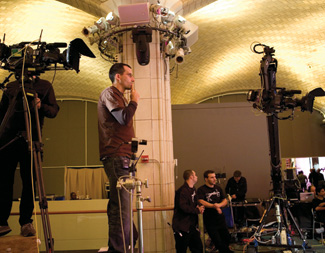 Croll figures out the lighting for the soaring, brick ceiling.
Croll figures out the lighting for the soaring, brick ceiling.
One thing Croll doesn't have to do is keep an eye on the clock, which is Charles' job. "That's all I do, figure out problems 18 hours a day," says Charles, describing how his phone starts ringing around 7 a.m. He's still answering e-mails past 10 p.m. He and Croll carry cellphones and two walkie-talkies at all times. "In order to make this show happen, it's a constant communication between us.
"One thing that amazes me about Tony," says Charles, "is his ability to be very boyish and charming and lighthearted in the face of exhaustion." He adds, "You work 60 days in a row with the same people. If you don't like them, you're going to have a miserable couple of months."
During the late afternoon, Croll and Charles break away from the runway location to check on the construction of the stage set at another secret location in Manhattan. It needs to be ready in two days for the first elimination round and appears far from finished. "I know these people are tired and way behind," says Croll, who draws up a list of priorities.
Then it's back to the runway location to rehearse cues one last time. After approximately 12 hours of setup, it is dark and raining outside. But the transformed space looks luminous. When the lights flash and the audio technicians boost their soundtrack levels, it pulsates. Everyone appears psyched for the big moment. "We're getting there," says Croll, taking a seat in the control room to watch the action through the monitors. "Let's start tighter," he says. "Don't be afraid of going wide and tilting up. Yea, that's great."
By 8 p.m., an excited, chattering audience is loaded in. Croll instructs Charles, who is on the floor, to get the crowd revved for some B-roll audience reaction shots. "Hello folks," says Charles, talking into a mic. "I need you to play along with me. I need you to pretend that they are hot models," referring to the crew who are sent again onto the catwalk in lieu of the models so that everything remains a surprise. After much clapping and hollering, it is finally time for the actual runway event to begin. "Okay," says Croll, through his mouthpiece from the control room. "Cue the music. Send out the first girl."